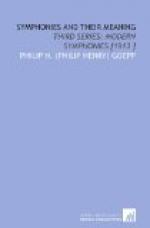and seal to the whole. The rest is a final happy refrain of all the strains, where the husband’s themes are clearly dominant.
CHAPTER XIX
ITALIAN SYMPHONIES
The present estate of music in Italy is an instance of the danger of prophecy in the broad realm of art. Wise words are daily heard on the rise and fall of a nation in art, or of a form like the symphony, as though a matter of certain fate, in strict analogy to the life of man.
Italy was so long regnant in music that she seems even yet its chosen land. We have quite forgotten how she herself learned at the feet of the masters from the distant North. For music is, after all, the art of the North; the solace for winter’s desolation; an utterance of feeling without the model of a visible Nature.
And yet, with a prodigal stream of native melody and an ancient passion of religious rapture, Italy achieved masterpieces in the opposite fields of the Mass and of Opera. But for the more abstract plane of pure tonal forms it has somehow been supposed that she had neither a power nor a desire for expression. An Italian symphony seems almost an anomaly,—as strange a product as was once a German opera.
The blunt truth of actual events is that to-day a renascence has begun, not merely in melodic and dramatic lines; there is a new blending of the racial gift of song with a power of profound design.[A] Despite all historical philosophy, here is a new gushing forth from ancient fount, of which the world may rejoice and be refreshed.
[Footnote A: In the field of the Lied the later group of Italians, such as Sinigaglia and Bossi, show a melodic spontaneity and a breadth of lyric treatment that we miss in the songs of modern French composers.
In his Overture “Le Baruffe Chiozzote” (The Disputes of the People of Chiozza) Sinigaglia has woven a charming piece with lightest touch of masterly art; a delicate humor of melody plays amid a wealth of counterpoint that is all free of a sense of learning.]
In a SYMPHONY BY GIOVANNI SGAMBATI,[A] IN D MAJOR, the form flows with such unpremeditated ease that it seems all to the manner born. It may be a new evidence that to-day national lines, at least in art, are vanishing; before long the national quality will be imperceptible and indeed irrelevant.
[Footnote A: Born in 1843.]
To be sure we see here an Italian touch in the simple artless stream of tune, the warm resonance, the buoyant spring of rhythm. The first movement stands out in the symphony with a subtler design than all the rest, though it does not lack the ringing note of jubilation.
The Andante is a pure lyric somewhat new in design and in feeling. It shows, too, an interesting contrast of opposite kinds of slower melody,—the one dark-hued and legend-like, from which the poet wings his flight to a hymnal rhapsody on a clear choral theme, with a rich setting of arpeggic harmonies. A strange halting or limping rhythm is continued throughout the former subject. In the big climax the feeling is strong of some great chant or rite, of vespers or Magnificat. Against convention the ending returns to the mood of sad legend.




